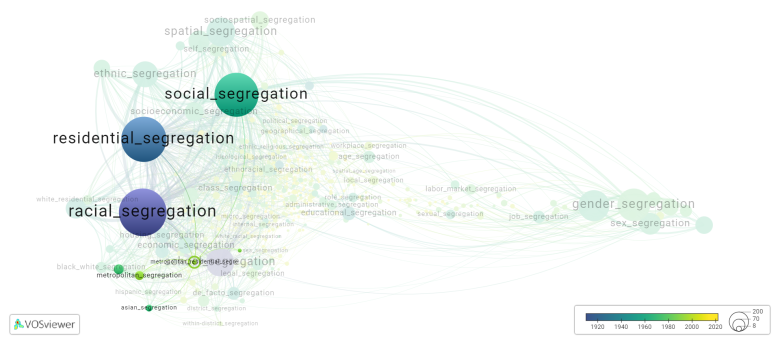Metropolitan residential segregation
Date and country of first publication[1]
2001
United States
Definition
Metropolitan residential segregation refers to the spatial separation of different racial or ethnic groups within a metropolitan area. It is the result of long-standing patterns of discriminatory practices, socioeconomic disparities, and rules and policies that have limited housing options for certain groups.
Residential segregation is often characterized by the concentration of minority groups in lower-income neighborhoods with limited access to resources and opportunities, while majority groups tend to live in wealthier, predominantly white neighborhoods. This segregation can have significant social, economic, and health consequences for individuals and communities.
The causes of metropolitan residential segregation are complex and multifaceted. Historical factors such as redlining, which denied mortgage loans to minority communities, and racial covenants, which restricted the sale of properties to certain groups, have contributed to the creation of segregated neighborhoods. Other factors include discriminatory lending practices, educational disparities, and employment discrimination, which can limit opportunities for minority groups to live in more affluent areas.
The consequences of residential segregation are profound. Segregated neighborhoods often have limited access to quality education, healthcare, employment opportunities, and public services. This perpetuates a cycle of poverty and reinforces socioeconomic inequalities. Additionally, segregated neighborhoods tend to have higher crime rates, lower property values, and limited social mobility.
Efforts to address metropolitan residential segregation have included fair housing laws, affirmative action policies, and initiatives aimed at providing affordable housing in more affluent areas. However, addressing segregation requires addressing the underlying systemic issues that perpetuate inequality. This includes policies aimed at improving educational opportunities, increasing access to quality healthcare and jobs, and actively combating discrimination in housing and employment.
In conclusion, metropolitan residential segregation refers to the division of different racial or ethnic groups within a metropolitan area. It is a result of historical and ongoing discriminatory practices and policies that limit housing options for certain groups. Addressing this issue requires a comprehensive approach that addresses systemic inequalities and promotes diversity and inclusion in all aspects of society.
See also
Related segregation forms
Metropolitan residential segregation is frequently discussed in the literature with the following segregation forms:
residential segregation, metropolitan segregation, social segregation, racial segregation, racial residential segregation, role segregation, latino white segregation

This visualization is based on the study The Multidisciplinary Landscape of Segregation Research.
For the complete network of interrelated segregation forms, please refer to:
References
Notes
- ↑ Date and country of first publication as informed by the Scopus database (December 2023).
Metropolitan residential segregation appears in the following literature
Flippen C.A. (2001). Residential segregation and minority home ownership. Social Science Research, 30(3), 337-362. Academic Press Inc..https://doi.org/10.1006/ssre.2001.0701
Iceland J. (2004). Beyond Black and White Metropolitan residential segregation in multi ethnic America. Social Science Research, 33(2), 248-271. Academic Press Inc..https://doi.org/10.1016/S0049-089X(03)00056-5
vonLockette N.D. (201). The impact of metropolitan residential segregation on the employment chances of blacks and whites in the United States. City and Community, 9(3), 256-273. https://doi.org/10.1111/j.1540-6040.2010.01332.x
Warner E.T., Gomez S.L. (201). Impact of neighborhood racial composition and metropolitan residential segregation on disparities in breast cancer stage at diagnosis and survival between black and white women in California. Journal of Community Health, 35(4), 398-408. https://doi.org/10.1007/s10900-010-9265-2
Britton M.L., Shin H. (2013). Metropolitan residential segregation and very preterm birth among African American and Mexican origin women. Social Science and Medicine, 98(), 37-45. https://doi.org/10.1016/j.socscimed.2013.08.039
Crowell A.R., Fossett M. (2018). White and Latino Locational Attainments: Assessing the Role of Race and Resources in U.S. Metropolitan Residential Segregation. Sociology of Race and Ethnicity, 4(4), 491-507. SAGE Publications Inc..https://doi.org/10.1177/2332649217748426
Kucheva Y. (2022). What Would It Take to Desegregate U.S. Metropolitan Areas? Pathways to Residential Desegregation by Race. Demography, 59(2), 433-459. Duke University Press.https://doi.org/10.1215/00703370-9737156
